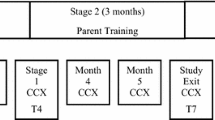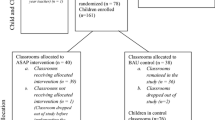Abstract
We assessed teacher responses to the communicative attempts of children with autism. Teachers were first interviewed using the Inventory of Potential Communicative Acts (IPCA) to identify behaviors in each child’s repertoire that the teachers considered to be communicative. Interview results suggested that the teachers interpreted many of the children’s prelinguistic gestures, body movements, and facial expressions, as forms of communication. Naturalistic observations were then conducted in the child’s classroom to determine how teachers responded to the children’s identified forms of prelinguistic behaviors. The results of these naturalistic observations suggested that the teachers often did not respond to the child’s prelinguistic behaviors in ways that acknowledged their communicative intent. Implications of the results on the child’s communication development and for intervention efforts are discussed.
Similar content being viewed by others
References
Baird, S., Mayfield, P., and Baker, P. (1997). Mothers’ interpretations of the behavior of their infants with visual and other impairments during interactions. J Visual Impairment Blindness 91: 467–483.
Bates, E., Camaioni, L., and Volterra, V. (1975). The acquisition of performatives prior to speech. Merrill-Palmer Q. 21: 205–226.
Bernard Opitz, V. (1991, August 16–20). Pragmatic Analysis of the Communicative Performance in Autistic Children. Paper presented at the 99th Annual Convention of the American Psychological Association, San Francisco, CA.
Bruininks, R. H., Woodcock, R. W., Weatherman, R. F., and Hill, B. K. (1984). Scales of independent behavior. Allen, TX: DLM Teaching Resources.
Bzoch, K., and League, R. (1991). Receptive-Expressive Emergent Language Scale (2nd ed.). Austin, TX: Pro-Ed.
Cirrin, F., and Rowland, C. (1985). Communicative assessment of nonverbal youths with severe/profound mental retardation. Mental Retard. 23: 52–62.
Coggins, T., and Carpenter, R. (1981). The communicative intention inventory: A system for observing and coding children’s early intentional communication. Appl. Psycholing. 2: 235–251.
Donnellan, A., Mirenda, P., Mesaros, R., and Fassbender, L. (1984). Analyzing the communicative functions of aberrant behavior. J. Assoc. Severely Handicapped 9: 201–212.
Dore, J. (1975). Holophrases, speech acts and language universals. J. Child Lang. 2: 21–40.
Drasgow, E., and Halle, J. (1995). Teaching social communication to young children with severe disabilities. Top. Early Childhood Special Educ. 15: 164–186.
Einfeld, S. L., and Tonge, B. J. (1994). Developmental Behavior Checklist, Monash University Press, Melbourne.
Halliday, M. (1975). Learning how to mean. In Lenneberg, E., and Lenneberg, E. (eds.), Foundations of Language Development: A Multi-Disciplinary Approach (Vol. 1), Academic Press, New York.
Hart, B., and Risley, T. R. (1995). Meaningful Differences in the Everyday Experience of Young American Children, Paul H. Brookes, Baltimore.
Haynes, W. (1998). Caretaker-child interaction. In Haynes, W., and Shulman, B. (eds.), Communication Development: Foundations, Processes and Clinical Applications, Williams and Wilkins, Baltimore, pp. 73–100.
Houghton, J., Bronicki, G. J., and Guess, D. (1987). Opportunities to express preferences and make choices among students with severe disabilities in classroom settings. J. Assoc. Persons Severe Handicaps 12: 18–27.
Iacono, T., Waring, R., and Chan, J. (1996). Sampling communicative behaviors in children with intellectual disability in structured and unstructured situations. Eur. J. Disord. Commun. 31: 106–120.
Kasari, C., Sigman, M., Mundy, P., and Yirmiya, N. (1988). Caregiver interactions with autistic children. J. Abnorm. Child Psychol. 16: 45–56.
Lambert, N. M., and Windmiller, M. B. (1981). AAMD Adaptive Behavior Scale—School Edition, American Association on Mental Deficiency, Washington, DC.
Linfoot, K. (1994). Functional communication and the role of context. In Linfoot, K. (ed.), Communication Strategies for People With Developmental Disabilities: Issues From Theory to Practice, MacLennan and Petty, Sydney, pp. 124–155.
McLean, J., and Snyder-McLean, L. (1987). Form and function of communicative behaviour among persons with severe developmental disabilities. Aust. New Zealand J. Dev. Disabil. 13: 83–98.
Rowland, C. (1990). Communication in the classroom for children with dual sensory impairments: Studies of teacher and child behavior. Augment. Alternat. Commun. 6: 262–274.
Sailor, W., and Mix, B. (1975). The Topeka Association for Retarded Citizens Assessment System, Pro-Ed, Austin, TX.
Sigafoos, J., and Pennell, D. (1995). Parent and teacher assessment of receptive and expressive language in preschool children with developmental disabilities. Educ. Train. Mental Retard. Dev. Disabil. 30: 329–335.
Sigafoos, J., Woodyatt, G., Keen, D., Tait, K., Tucker, M., Roberts-Pennell, D., and Pittendreigh, N. (2000). Identifying potential communicative acts in children with developmental and physical disabilities. Commun. Disord. Q. 21(2): 77–86.
von Tetzchner, S. (1997). Communication skills among females with Rett syndrome. Eur. Child Adolesc. Psychiatr. 6: 33–37.
Warren, S., Yoder, P., Gazdag, G., Kim, K., and Jones, H. (1993). Facilitating prelinguistic communication skills in young children with developmental delay. J. Speech Hearing Res. 36: 83–97.
Watson, L. R. (1998). Following the child’s lead: Mothers’ interactions with children with autism. J. Autism Dev. Disord. 28: 51–59.
Wetherby, A., and Prizant, B. (1992). Facilitating language and communication development in autism: Assessment and intervention guidelines. In Berkell, D. (ed.), Autism: Identification, Education and Treatment, Erlbaum, New Jersey, pp. 107–134.
Wetherby, A., and Prutting, C. (1984). Profiles of communicative and cognitive-social abilities in autistic children. J. Speech Hearing Res 27: 364–377.
Yoder, P., Warren, S., Kim, K., and Gazdag, G. (1994). Facilitating prelinguistic communication skills in young children with developmental delay II: Systematic replication and extension. J. Speech Hearing Res 37: 841–851.
Yoder, P., Warren, S., McCathren, R., and Leew, S. (1998). Does adult responsivity to child behavior facilitate communication development? In Wetherby, A., Warren, S. and Reichle, J. (eds.), Transitions in Prelinguistic Communication (Vol. 7), Paul H Brookes, Baltimore, pp. 39–58.
Yoder, P. J. (1987). Relationship between degree of infant handicap and clarity of infant cues. Am. J. Mental Defic. 91: 639–641.
Author information
Authors and Affiliations
Corresponding author
Rights and permissions
About this article
Cite this article
Keen, D., Sigafoos, J. & Woodyatt, G. Teacher Responses to the Communicative Attempts of Children With Autism. J Dev Phys Disabil 17, 19–33 (2005). https://doi.org/10.1007/s10882-005-2198-5
Issue Date:
DOI: https://doi.org/10.1007/s10882-005-2198-5




